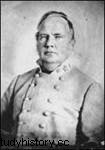 While the armies maneuvered without succeeding, or even really trying, to engage in a major confrontation, the campaign of Kentucky would experience ramifications on an unexpected scale several hundred miles away, in Mississippi . At the beginning of September, the southern troops based in this State began the diversionary operations entrusted to them by Bragg within the framework of his plan. Sterling Price, who commanded a force of 8,000 men detached from Van Dorn's army, attacked first in the direction of Nashville, in order to prevent Grant from sending reinforcements to Buell.
While the armies maneuvered without succeeding, or even really trying, to engage in a major confrontation, the campaign of Kentucky would experience ramifications on an unexpected scale several hundred miles away, in Mississippi . At the beginning of September, the southern troops based in this State began the diversionary operations entrusted to them by Bragg within the framework of his plan. Sterling Price, who commanded a force of 8,000 men detached from Van Dorn's army, attacked first in the direction of Nashville, in order to prevent Grant from sending reinforcements to Buell.
Collision at Iuka
Leaving Tupelo, Price approached Iuka on September 13, 1862 , a small railroad station on the Memphis &Charleston Railroad located about thirty kilometers east of Corinth. It was only held by a small garrison of 2,000 northern soldiers, which its commander had hastily evacuated during the night. Price and his men captured the depot there. He was to wait there for Van Dorn to join him with 7,000 additional men, before launching further operations against Grant's forces. Van Dorn, however, suggested that Price meet him instead, to which the Missourian nodded. On September 19, Price ordered his troops to stand ready to leave the place.
Grant, however, had been quick to react to his foray. Arriving in person at Corinth with two divisions commanded by Edward Ord, he came to reinforce Rosecrans who had two others. On Rosecrans' recommendation, Grant decided to employ this force of 17,000 men in a complex maneuver designed to ensnare Price and destroy his army. While the two divisions of Ord would attack in front, directly from Corinth, those of Rosecrans would embark on a flank march intended to cut off any Confederate retreat. Rosecrans planned to take two separate routes for this, Jacinto and Fulton, which would allow him to reach Iuka from two different directions – from the southwest and southeast, respectively. The sky, however, prevented him from carrying out this plan:heavy rains turned the poor roads of the region into quagmires, slowing his troops considerably. On September 18, Ord was already ready to attack, but Rosecrans was still far away. This delay, and the fear that his two divisions would be unable to support each other if they came from two directions at the same time, prompted the latter to abandon his initial order of march. When at dawn on September 19 , the Rosecrans column resumed its march, it was to approach Iuka by the only road to Jacinto.
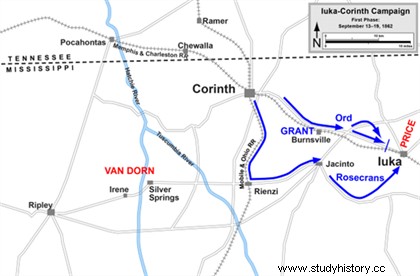 Preliminary movements to the Battle of Iuka, September 1862. Map by Hal Jespersen (www.cwmaps. org).
Preliminary movements to the Battle of Iuka, September 1862. Map by Hal Jespersen (www.cwmaps. org).
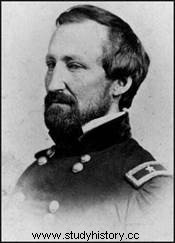 Warned of Rosecrans' delay, Grant instructed Ord to approach within six kilometers of Iuka, then to wait for Rosecrans to engage in combat – which would not fail to be understood – to attack Price in turn. The march from Rosecrans was slow and lasted most of the day. Quickly informed by his scouts, Price took advantage of Rosecrans's caution and Ord's wait-and-see attitude to make arrangements to escape the trap that the Northerners held out to him. The Missourian had with him the four brigades of Henry Little's division, reinforced by a brigade of cavalry – the latter having, the previous month, carried out a successful raid under Frank Armstrong in western Tennessee. While his pickets slowed Rosecrans' advance, in the afternoon Price was able to get enough troops through in a southwesterly direction to face him. Around 4:30 p.m., the leading elements of Rosecrans, Charles Hamilton's division, was attacked in force by the Confederates near a crossroads. Hamilton fronted with composure, deploying an Ohio battery to command the crossroads, John Sanborn's brigade in immediate support, and Jeremiah Sullivan's in reserve.
Warned of Rosecrans' delay, Grant instructed Ord to approach within six kilometers of Iuka, then to wait for Rosecrans to engage in combat – which would not fail to be understood – to attack Price in turn. The march from Rosecrans was slow and lasted most of the day. Quickly informed by his scouts, Price took advantage of Rosecrans's caution and Ord's wait-and-see attitude to make arrangements to escape the trap that the Northerners held out to him. The Missourian had with him the four brigades of Henry Little's division, reinforced by a brigade of cavalry – the latter having, the previous month, carried out a successful raid under Frank Armstrong in western Tennessee. While his pickets slowed Rosecrans' advance, in the afternoon Price was able to get enough troops through in a southwesterly direction to face him. Around 4:30 p.m., the leading elements of Rosecrans, Charles Hamilton's division, was attacked in force by the Confederates near a crossroads. Hamilton fronted with composure, deploying an Ohio battery to command the crossroads, John Sanborn's brigade in immediate support, and Jeremiah Sullivan's in reserve.
On the southern side, Louis Hébert's brigade launched a sustained assault on this position. The Louisiana general, captured in March at Pea Ridge and then exchanged, was twice driven back by heavy fire. During this action, Little was killed by a bullet to the head as he rode right next to Price. On the third attempt, Hébert's brigade managed to seize the northern battery at the crossroads, which had lost almost all of its horses and almost all of whose servants were killed or wounded. Price wanted to push his advantage, extending the clash beyond sunset, but the Confederates didn't make much progress. When Sullivan's brigade came into play, there were southern attempts to outflank the federal system by engaging the two halves of John Martin's brigade on either side of Hébert's. The Union right began to retreat, but the arrival of Rosecrans' other division, commanded by David Stanley, halted the Confederate advance - not without luck, for one of the Southern regiments suspended its fire, confusing the Union reinforcements, in darkness, with friendly units. Soon it was too dark to fight , and around 7 p.m. the shooting stopped.
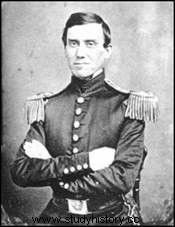 Throughout the encounter, Ord's men did not move an inch. Grant and Ord claimed to have heard absolutely nothing of what was happening while they were less than three miles away. The testimonies of other officers, claiming to have heard the fight when they were further away, are not incompatible with the phenomenon of acoustic shadow , commonly reported during the Civil War. Grant's behavior, however, would fuel further controversy. Rumors said he was dead drunk on the day of the battle. It was, moreover, not totally inconceivable, since the main interested party would confess in his memoirs that the fall of 1862, a period when he was confined to the defensive with increasingly reduced numbers in the face of aggressive Confederate armies , had been the darkest hour of the war for him – and Grant, while perhaps not an alcoholic as such, was known to indulge in alcohol when under pressure .
Throughout the encounter, Ord's men did not move an inch. Grant and Ord claimed to have heard absolutely nothing of what was happening while they were less than three miles away. The testimonies of other officers, claiming to have heard the fight when they were further away, are not incompatible with the phenomenon of acoustic shadow , commonly reported during the Civil War. Grant's behavior, however, would fuel further controversy. Rumors said he was dead drunk on the day of the battle. It was, moreover, not totally inconceivable, since the main interested party would confess in his memoirs that the fall of 1862, a period when he was confined to the defensive with increasingly reduced numbers in the face of aggressive Confederate armies , had been the darkest hour of the war for him – and Grant, while perhaps not an alcoholic as such, was known to indulge in alcohol when under pressure .
Other gray areas concern his relationship with Rosecrans. While he was undeniably aggressive and enterprising, qualities rare in a northern general in 1862, Grant also displayed the keen political sense that was to enable him, a few years later, to become the undisputed figurehead of the Republican party, and to be twice elected President of the United States. Grant had a certain propensity to want to put under the extinguisher the subordinates whom he considered potential rivals , whether from a political point of view or on a purely military level, and this was perhaps the case with Rosecrans. The fact is that after praising him in a first report written the day after the battle, Grant said nothing of Rosecrans in a second report, dated October 22, where he gave full credit for the action to Iuka. to Charles Hamilton alone. Some have even suggested that Grant deliberately left Rosecrans to fend for himself, turning a deaf ear to the noise of battle or, at the very least, ignoring the clouds of smoke reported by some of Edward Ord's soldiers. Grant, moreover, did not hesitate to blame Rosecrans for not having managed to destroy Price's army at Iuka, and he would develop doubts about his ability to command. Elements that hardly plead in his favor - any more than the fluctuating accounts that he will give, over the years, of this affair.
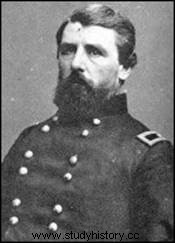 During the night, Rosecrans prepared to renew the fight at dawn on September 20, but Price, for his left, took advantage of the darkness to evacuate the place – by the road to Fulton, the very one that Rosecrans had given up on blocking the day before. The Northerners cautiously reoccupied the deserted Iuka before setting off in pursuit of their enemies, but their state of fatigue, as well as the ambushes set by Armstrong's horsemen, soon dissuaded them from going any further. Although modest in scale, the Battle of Iuka had been one of great violence. Rosecrans and Price had hardly committed more than half of their respective forces, but they had nevertheless lost, respectively, about 800 and 1,500 men – including more than 400 killed in total. Generally presented as a northern victory, it was more a draw tactical – neither of the two belligerents having really taken the advantage on the battlefield – and strategic. True, Union forces reoccupied Iuka, but Price's had no intention of staying there anyway. Moreover, Grant's avowed objective, the destruction of Price's army, was not achieved.
During the night, Rosecrans prepared to renew the fight at dawn on September 20, but Price, for his left, took advantage of the darkness to evacuate the place – by the road to Fulton, the very one that Rosecrans had given up on blocking the day before. The Northerners cautiously reoccupied the deserted Iuka before setting off in pursuit of their enemies, but their state of fatigue, as well as the ambushes set by Armstrong's horsemen, soon dissuaded them from going any further. Although modest in scale, the Battle of Iuka had been one of great violence. Rosecrans and Price had hardly committed more than half of their respective forces, but they had nevertheless lost, respectively, about 800 and 1,500 men – including more than 400 killed in total. Generally presented as a northern victory, it was more a draw tactical – neither of the two belligerents having really taken the advantage on the battlefield – and strategic. True, Union forces reoccupied Iuka, but Price's had no intention of staying there anyway. Moreover, Grant's avowed objective, the destruction of Price's army, was not achieved.
Whatever their responsibilities were in the outcome of the battle at Iuka, Grant, having lost contact with Price, had only to redeploy his forces in anticipation of the next action of his enemies. He sent Ord's two divisions to join Stephen Hurlbut's at Bolivar, Tennessee, northwest of Corinth. Their combined forces amounted to 12,000 men. While William Sherman held Memphis with 7,000 troops, Grant established his headquarters in Jackson, set back from his main strongpoints, where he kept 6,000 fighters in reserve. Recognizing, however, in Corinth the centerpiece of its system , he sent two other divisions there to reinforce Rosecrans. The latter had a total of 23,000 men there:15,000 in the city itself, and 8,000 others dispersed among five neighboring localities. The main problem with the Feds was that they had no idea what their enemies were planning. To make matters worse, Van Dorn and Price multiplied the maneuvers intended to mystify them.
Van Dorn's curious strategy
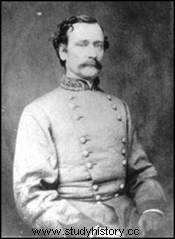 Van Dorn had left Tupelo to settle in Holly Springs, further northwest, as if he marched on Memphis. He had been joined there by Mansfield Lovell's division, taken from the defenses of Vicksburg - the city no longer being directly threatened by the Northerners. On September 24, he led his force unexpectedly east to Ripley, where he joined Price's men on the 28th. with Rosecrans – because Van Dorn, too, saw Corinth as a key position, and he had every intention of taking it . His forces included ten infantry brigades articulated in three divisions, those of Lovell, Hébert – who had taken over from Little – and Dabney Maury; to these were added two brigades of cavalry. While his enemies were scattered, Van Dorn had the advantage of being able to concentrate his forces. He also had that of surprise, his riders effectively covering his moves.
Van Dorn had left Tupelo to settle in Holly Springs, further northwest, as if he marched on Memphis. He had been joined there by Mansfield Lovell's division, taken from the defenses of Vicksburg - the city no longer being directly threatened by the Northerners. On September 24, he led his force unexpectedly east to Ripley, where he joined Price's men on the 28th. with Rosecrans – because Van Dorn, too, saw Corinth as a key position, and he had every intention of taking it . His forces included ten infantry brigades articulated in three divisions, those of Lovell, Hébert – who had taken over from Little – and Dabney Maury; to these were added two brigades of cavalry. While his enemies were scattered, Van Dorn had the advantage of being able to concentrate his forces. He also had that of surprise, his riders effectively covering his moves.
Corinth, however, was by no means an easy target. During and after its siege, the city had been surrounded by powerful field fortifications . Those established by the Confederates themselves were mainly facing north, and constituted the outermost belt. The Northerners, however, had added two more lines of defense. One, intermediate, had been baptized "Halleck line", faced mainly south and consisted of deep abatis flanked by redoubts. The other, on the immediate outskirts of the town and the valuable railway junction, consisted of a series of batteries defending Corinth in all directions. Since most of them were established on a hill rising less than a mile southwest of the railway depot, these inner defenses were known as the "College Hill line". The problem for the Northerners was that they did not have enough forces to hold such formidable entrenchments. Equal in number, Rosecrans' army was equally equal to that of his enemies in organization, the four divisions of Stanley, Hamilton, Thomas Davies, and Thomas McKean numbering a total of ten brigades; there was also a small division of two cavalry brigades, commanded by John Mizner.
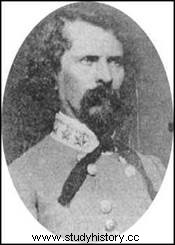 Van Dorn knew that no matter which way he approached Corinth would be hard to take. The element of surprise could give him a decisive advantage, and it was this surprise that he strove to obtain - by developing again, as seven months earlier at Pea Ridge, an audacious plan . The Southern general decided to march north from Ripley and then attack Corinth from the northwest. The march to the north, which allowed him to threaten both Corinth and Bolivar, keeping his opponents uncertain about his real intentions. As for the attack itself, it would arrive from an unforeseen direction which would allow the defenders to be taken from behind while isolating them from possible reinforcements. The idea - like Van Dorn's battle plan at Pea Ridge - seemed valid, but it also had serious flaws:on the one hand, it would force the attackers to strike a point where the defenses established by the Northerners were added those the Confederates had themselves built the previous spring; and on the other hand, by attacking from the northwest, the Southerners would turn their backs on the Federals posted in Bolivar, thus exposing themselves to being taken in the rear – or worse, to seeing their retreat cut off.
Van Dorn knew that no matter which way he approached Corinth would be hard to take. The element of surprise could give him a decisive advantage, and it was this surprise that he strove to obtain - by developing again, as seven months earlier at Pea Ridge, an audacious plan . The Southern general decided to march north from Ripley and then attack Corinth from the northwest. The march to the north, which allowed him to threaten both Corinth and Bolivar, keeping his opponents uncertain about his real intentions. As for the attack itself, it would arrive from an unforeseen direction which would allow the defenders to be taken from behind while isolating them from possible reinforcements. The idea - like Van Dorn's battle plan at Pea Ridge - seemed valid, but it also had serious flaws:on the one hand, it would force the attackers to strike a point where the defenses established by the Northerners were added those the Confederates had themselves built the previous spring; and on the other hand, by attacking from the northwest, the Southerners would turn their backs on the Federals posted in Bolivar, thus exposing themselves to being taken in the rear – or worse, to seeing their retreat cut off.
So had Earl Van Dorn learned nothing from his defeat at Pea Ridge? The Mississippian was first and foremost a cavalry officer, ever since he left West Point in 1842 – ironically, the same year as Rosecrans. He reasoned as such, seeking to use mobility to surprise the opponent and strike him in a sudden and decisive manner. It was an exercise for which he was completely comfortable, as the rest of his career would show. But as an army commander, Van Dorn apparently did not realize that a combined force consisting mainly of infantry, artillery and supply wagons could never attack or retreat as quickly as a troop formed exclusively of mounted soldiers. This incompressible slowness meant that at the slightest grain of sand, the entire army could find itself in an extremely perilous situation. That's what happened at Pea Ridge. But Van Dorn apparently didn't learn the lesson – probably because he simply did not understand the causes of his defeat.
Sources
- Page dedicated to the battles of Iuka and Corinth, with several documents, in particular the account made by Charles Hamilton for the series Battles and Leaders .
- On the same site, the official reports of Rosecrans, Grant, Van Dorn and Price on the battles of Iuka and Corinth.
- The Civil War Preservation Trust page dedicated to the Battle of Iuka.
- General article on the Battle of Iuka.